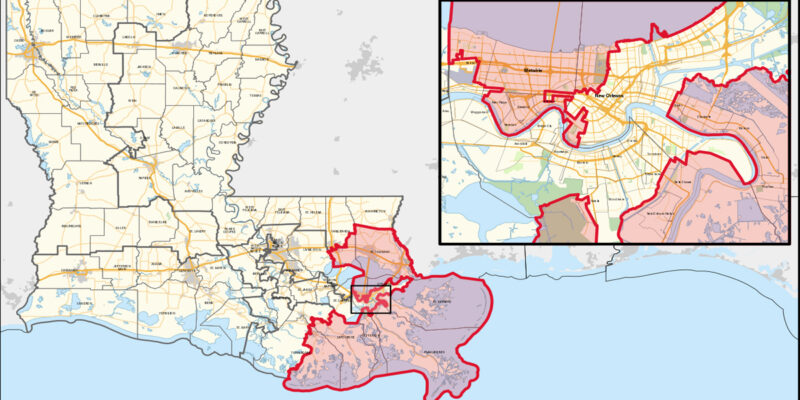Against all odds – and jurisprudential good sense – Louisiana finds itself having to revisit congressional reapportionment, although unlikely with any changes until after 2024, if even then.
Over a year ago, the chances of the state having to follow the dictates of special interest groups in drawing two majority-minority congressional districts rather than maintaining its one were about as likely as a football team succeeding with a Hail Mary pass at a game’s end. Yet with a Supreme Court decision since on an Alabama reapportionment case, it seems the ball actually got hurled with enough strength to reach the goal line and offensive players in position to catch it.
But the offense has to come down with it. Whether it does begins with the Court also declining to hear the state’s appeal of a district court decision a year ago that set the stage for drawing the two M/M map after the state legislated a one M/M map not too different from that of the present.
That means the Court thinks its recent Allen v. Milligan decision provides sufficient guidance for lower courts to implement in this case. That is, despite the wording of the Voting Rights Act, previous court rulings that allowed for non-neutral application of race in guiding reapportionment remain in place, giving race a preferred position among several recognized principles of reapportionment.
Practically speaking, the Fifth Circuit Court of Appeals has the case, where, if it thinks Louisiana’s case is sufficiently different from Alabama’s, will overturn the Middle District court’s ruling. If not, it can ask the Legislature to try again, but if for whatever reason it doesn’t think the Legislature can create a plan tailored to the jurisprudence at present, it will skip that step and allow the district court directly to impose a two M/M solution.
Actually, it kind of works out the same. Politically speaking, the Legislature is unlikely in special session to submit to a two M/M plan, because GOP legislators who comprise a supermajority simply won’t sign over the likely converting of a Republican representative into a Democrat.
But it also makes good jurisprudential sense because of the exceptionally confused Supreme Court ruling that signals the last hasn’t been heard on this issue that isn’t close to resolution. The convoluted ruling leaves room for drawing another one M/M map slightly different from the first that produces an even sharper distinction between race and other criteria used, principally communities of interest.
This would illuminate even more the greater role race takes in evaluating the Louisiana plans than in the Alabama ones, where the adopted one M/M plan didn’t much more neatly observe other principles than did the two M/M rivals. By contrast, the Louisiana one M/M plan is much cleaner in its fidelity to other principles compared to the rather severe violence done to these in the name of race by any two M/M plan, which may tip the scales in the minds of the Circuit Court to follow genuinely the words of the Voting Rights Act that says race cannot have so much prominence as to guarantee proportionality in population and representation. It also would have to demonstrate a state frustrates minority representation where plaintiffs have to overcome the fact that since 1990 many elected Democrats, including many blacks, with influence in the process explicitly rejected proportionality-based mapping sought by the plaintiffs.
Advertisement
As impaired as it is, the ruling does make clear that at least two challenges not yet considered by the Court could be brought: that race-conscious criteria inserted into the law by the Court may have grown stale and that the entire section of the Act interpreted to allow the injection of race as a criterion is unconstitutional. Indeed, while there are those on the hard left who with the ruling consider the creation of two M/M districts a done deal in time for 2024, hard leftists in the legal profession expressed alarm at the ruling precisely because they see it granting only a tenuous, even temporary, vehicle by which to keep race as a criterion.
Thus, whether the Legislature has a reapportionment special session matters only in the speed in which the matter winds back up in court if a court doesn’t find a one M/M plan acceptable (taking comments from GOP state Sen. Sharon Hewitt who led the effort in her chamber, a challenge in that case from the Legislature is inevitable). At the very least, the process will take months to play out, starting when the Fifth Circuit decides what to do.
Add to this the Court’s Purcell principle, which means to avoid electoral confusion changes in boundaries can’t happen too soon to the start of the election process. In practical terms, that means in Louisiana all litigation would have to be wrapped up by the end of May, 2024. In fact, it may be more like the end of January because state Republicans choose delegates for the national convention in part by congressional districts, with the primary election on Mar. 23. In neither instance litigation will be complete, and the decision courts, likely involving again the Supreme Court, make in 2024 or 2025 may be to uphold through different reasoning the present map or something near it, so a two M/M adopted plan may not materialize for 2026 or ever.
So, it’s not that the ball has been grabbed by an offensive player who just has to reel it in. There are plenty of defenders yet with a shot to see that doesn’t happen. Any judgment that Louisiana inevitably will end up with a two M/M solution soon is most decidedly premature.
Advertisement
Advertisement

